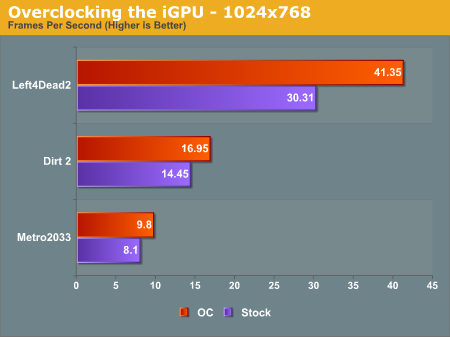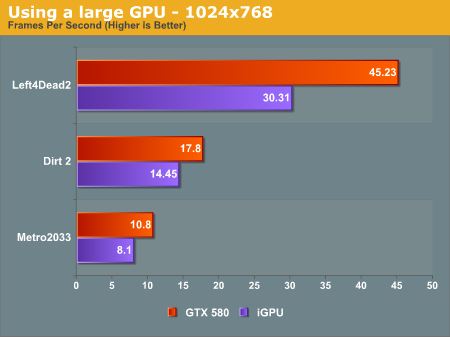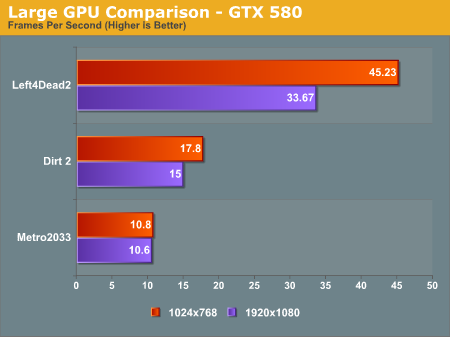Fusion E-350 Review: ASUS E35M1-I Deluxe, ECS HDC-I and Zotac FUSION350-A-E
by Ian Cutress on July 14, 2011 11:00 AM ESTI decided to dedicate an extra page to looking at two features on these Fusion boards that are, in my eyes, quite interesting to discuss.
On the one hand, we are dealing with low power CPUs which can't process that much very fast, so if you want to overclock them, that overclock also has a significant impression on any integrated GPU gaming being used.
On the other, we have access to a PCIe x16 slot, capable of running a full length, high-end GPU (should you want to). This PCIe slot actually runs at 4x, which in certain circumstances would cripple the discrete GPU. Pair this crippling with a not-so-great CPU, and we're not expecting the gaming capability to take off, so I've examined this as well.
Overclocking, and Gaming Performance
By default, we have a 1600 MHz, dual core Fusion CPU, combined with an 80 SP iGPU at 500 MHz, designated the HD 6310. In terms of pure CPU throughput, we saw on all boards that a percentage increase in clock speed gave a direct increase in benchmark result for the 3D Particle Movement benchmark.
In terms of gaming, we need to analyze what this overclock does. Apart from the default CPU speed increase, we're getting a direct GPU clock speed increase as well. The DDR3 memory is also getting an increase, thus the memory bandwidth to the iGPU is increased as well. So any overclock will increase its own effectiveness in two major areas.
I'll take the ASUS E35M1-I Deluxe for this explanation, which allowed a 10% overclock from 1600 MHz to 1760 MHz. From the gaming perspective on the iGPU, we have a large increase in scores:


Out largest increase was in the DirectX 9 game, Left4Dead2 - a staggering 36.4 % increase in frame rate from 30.3 fps to 41.4 fps, making the game more playable at the 1024x768 resolution. Even Metro2033 had a 21.0 % increase, and Dirt2 a 17.3% increase. Is the iGPU itself capable of playing the major games? Probably not, but at least those older ones can feel smoother.
The PCIe slot running at 4x - Is it worth using a beefy GPU, like a GTX 580?
The short answer is no, probably not. Normally we see a full length PCIe slot run at 4x only when it's the second or third PCIe slot on the board, and usually at the detriment to SATA or USB ports that have to be switched off as a result. Here, we have two main issues - will the CPU be fast enough to be able to navigate data across the PCIe bus to and from the discrete graphics, or will the 4x speed of the bus be the crippling factor?
(Note: I understand getting a GTX580 isn't realistic with a Fusion, but it's the most powerful GPU I have to hand and most apt for this test as GPU power should not be an issue.)
For this test, I ran the GTX 580 at the same settings as the iGPU tests, and then at the 1920x1080 resolutions and settings that we normally do for the high end motherboards (8xMSAA, 16xAF). First, at the iGPU resolutions on the ASUS E35M1-I Deluxe:

Despite using a $500 GPU, our biggest increase in frame rate, at 1024x768 resolution, is only 50%. In Left4Dead2 on Sandy Bridge, at 1680x1050, we see over 200 fps - we know L4D2 can be fairly CPU limited, so the fact that we only see 45 fps is definitely testament to the Fusion CPU.
Now, at the full 1920x1080 resolution:

In Metro 2033, we didn't see any real decline from 1024x768 to 1920x1080, but there was a significant drop in Left4Dead2. These results are also due to the CPU holding the GPU back, meaning that even with a GTX 580 on Fusion, only the old games will be playable, but this time at a higher resolution.










67 Comments
View All Comments
CZroe - Saturday, July 16, 2011 - link
Regarding the Asus board not having HDMI1.4, you never seem to confirm that the others do or don't. have it. Should I assume they do or don't?"...and a Wifi card with a pair of antenna"
Antennae is the plural of "antenna." ;)
You wonder about the VGA reference in the Asus board's BIOS, but other boards clearly include a DVI to VGA adapter. Even if the Asus board doesn't include it, it could be referring to that unless it is DVI-D only. Does it support a VGA adapter?
"how overclocking effects gaming"
"Effects" should be affects.
Akdor 1154 - Saturday, July 16, 2011 - link
Given these boards are clearly pushed at the HTPC usage scenario (HDMI, TOSLINK optical outputs, one of the most powerful onboard GPUs ever made, passive cooling, etc) it is very disappointing to not see any of this functionality tested out.How did they perform decoding video? Given the high CPU usage on network utilization, is there any issue playing high bitrate content from a NAS somewhere else? Can I encode? How did the GPU perform on OpenCL tasks (namely, again, content encoding)? Can the PCI-E slot take a TV tuner? What about Flash, if only for Youtube? How about upscaling low-resolution content?
And for the love of God, given two passive and one active cooling setups, how did they fare in a REAL case? Don't know many people who run their HTPCs in open-air, and the nice small cases available can be quite restrictive in terms of airflow - so will the passively cooled boards even be suitable for these? How about fan noise? It would seem Zotac and ASUS went passive because of noise concerns, so how bad was the ECS's little 40mm fan?
What about WiFi performance? You complained about one only supporting HDMI 1.3b; did the others support 1.4 (and hence 3D) perfectly? Did you test this? There was an issue with Windows' audio buffer latency - it would have been great to see this actually tested out to see if it made any difference, instead of a vague "some people might be able to hear it". Did the problematic board skip at all?
Summing up the lack of insight in the way this review was carried out.. <b>did you even test Blu-Ray playback</b>?
I'd love to see this information added to this review - I'd also be interested to know how many people you think would purchase this intending to run Metro 2033 on it.
And finally it seems your comment form is broken in Opera.
evolucion8 - Sunday, July 17, 2011 - link
And the odd thing is when they were testing its IGP performance with Metro 2033, calling it "the Crysis of DX11 until Crysis 2 arrives, so Crysis 2 haven't been released yet? Mishmash of old and new sentences of old articles glued together. Pretty much the same thing that apoppin does on Allienbabletech and his horrible lack of focus and handbacked marketing propagandism.Plus the fact that the review has a lack of objectivity as it isnt compared to its direct rival the Atom/ION combination. I wonder who will stick a GTX 580, play games or will use it for WinRaR archiving. Atom and Fusion aren't powerhouses, are CPU's for very basic stuff and HTPC and they would had done tests in that arena, like web browsing tests, movie playback, Flash tests, USB and HD performance etc. Totally irrelevant, how low can this go?! Definitively one of the worst reviews I've ever seen.
Overall, a HTPC oriented system tested with unconventional tests against much more expensive and powerful solutions. It is like taking a Ferrari and test its performance under water and in outerspace and comparing it against the Columbia Shuttle and Navy's Nuclear Submarine. Things had gone under spiral lately and integrity has been long gone in here, a pity.
PR3ACH3R - Sunday, July 17, 2011 - link
@ Ian CutressThanks for the review,
I think you touched upon a few important points like thermal performance, but as a whole, this review leaves a lot to be desired.
it is incomplete, & fails to address what the target audience of these products, wants to know.
Did this review help me decide what board to buy for HTPC use?
I'm afraid not.
Ichinisan - Sunday, July 31, 2011 - link
It's pretty clear why the Asus BIOS mentions "VGA." The Asus and Zotac boards have DVI-I connectors, so they have extra pins for analog and work with a VGA adapters.dakky21 - Saturday, November 5, 2011 - link
I registered on this board just to say that... not ALL boards have overclock function !!!!I just bought HDC-I v1.0 yesterday, in fact only because I read it had overclock option, but what a cold shower - it does not have. At least not where it should be, under Frequency/Voltage control in BIOS.
dakky21 - Sunday, November 6, 2011 - link
To clarify, my board has BIOS version 2.10.1208 (03/24/2011) and there is NO Turbo Mode in Frequency/Voltage control. No way of getting around 33% more speed. Unfortunately, I bought this board just because of that. Never again trust reviewers or ECS...